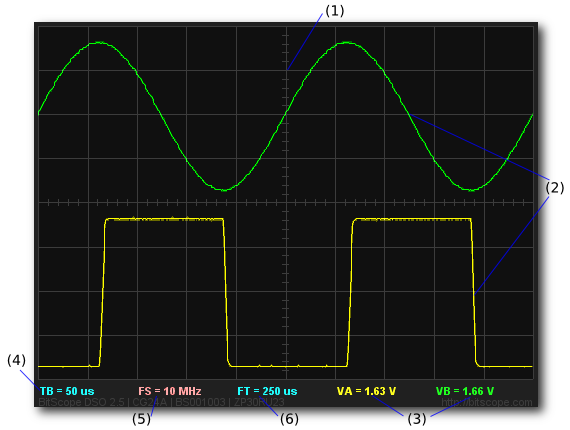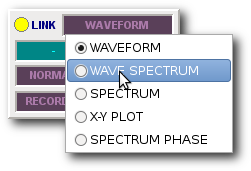
The oscilloscope display above is selected when DSO is first powered on. It comprises:
| ID | FEATURE | DESCRIPTION |
| (1) | Graticule | Display graticule (X-Axis 10 Divisions, Y-Axis 8 Division). |
| (2) | Waveforms | Waveforms connected to CH-A and CH-B. |
| (3) | DC Voltages | Measured DC (or bias) voltages on CH-A and CH-B. |
| (4) | Zoom Timebase | The zoom timebase value (reported as time per division). |
| (5) | Sample Rate | The sample rate at which the waveforms were captured. |
| (6) | Focus Time | The time at the centre of the display (relative to the trigger). |
This is BitScope DSO's standard dual channel oscilloscope display format. In this example, two 4kHz 3.3Vpp waveforms sampled at 10MHz are shown each with a 1.65V DC (bias) voltage.
There are many other display formats available. They are grouped by virtual instrument.

For example, logic capture offers timing diagrams and mixed signal displays whereas analog capture includes spectrum analyzer and X-Y plot displays.
Most displays support a range of other features including decay phosphors, time and frequency cursors, region bands and signal variables.
The active display is selected via Act On Gestures on the capture control display format widget.
A Click or Select switches between the current format and the previous one and a Menu-Click pops up the format menu for other display formats.
In this example (taken from the SCOPE virtual instrument running on a BS10) the options include WAVEFORM, WAVE SPECTRUM, SPECTRUM, X-Y PLOT and SPECTRUM PHASE.
The display formats supported across all instruments in the current DSO version are:
| FORMAT | DESCRIPTION |
| WAVEFORM | Time domain analog waveform (digital oscilloscope). |
| SPECTRUM | Frequency domain analog spectrum magnitude (spectrum analyzer). |
| WAVE SPECTRUM | Time and frequency domains combined in one display. |
| SPECTRUM PHASE | Frequency domain spectrum magnitude and phase (spectrum analyzer). |
| X-Y PLOT | X-Y plot (lissajous) of data on Channel A vs B, C and/or D. |
| LOGIC STATE | Logic state (timing) display (8 channels, logic analyzer). |
| WAVE LOGIC | Analog waveform and logic state (timing) display combined. |
| LOGIC VALUE | Logic value (decoded) data display (8 channels, logic analyzer). |
Below are some screenshots of some of the more commonly used display formats.
When DSO captures analog and logic signals together, the default is a split analog and logic display.
The timing of the analog and logic waveforms is synchronized so that time measurements can be made between any combination of analog and logic channels.
Often it is desirable to see a waveform and its associated spectrum together.
This example shows a triange waveform and its magnitude spectrum. The graticule switched off and cursors are enabled. The cursors measure magnitude and frequency at the top and time and voltage at the bottom. Some of the measurements are shown on the display (e.g. the frequency measured from the spectrum is 4kHz) and others on the cursor panel (which in this example reports the Vpp and waveform period).
Like most dual channel scopes, DSO provides a X-Y phase plot display.
Here two sinusoidal waveforms of almost the same frequency are shown plotted against other.
Several spectrum display formats are available. This one shows magnitude and phase.
This shows a phase density plot and magnitude spectrum of a pair of related signals.
This screenshot looks a little different to the others because it was taken on a very high resolution display with the DSO maximized to full-screen. Click the image to see it full size.